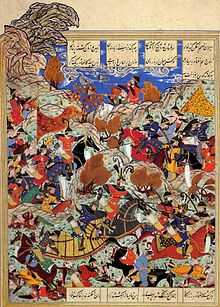Siege of Damascus (1400)
| Siege of Damascus 1400 | |||||||
|---|---|---|---|---|---|---|---|
 Timur defeating the Mamluk Sultan Nasir-ad-Din Faraj[1] | |||||||
| |||||||
| Belligerents | |||||||
|
|
| ||||||
| Commanders and leaders | |||||||
| Timur | Nasir-ad-Din Faraj | ||||||
| Strength | |||||||
| Unknown | Unknown | ||||||
| Casualties and losses | |||||||
| Unknown | all killed | ||||||
Background
Timur was one of the most powerful Central Asian rulers since Genghis Khan. By long and relentless fighting, he sought to rebuild the Mongol Empire of his predecessors.[4][5]
Before the end of 1399, Timur started a war with the Mamluk sultan of Egypt Nasir-ad-Din Faraj and invaded Mamluk Syria. Timur's forces took Aleppo[6] He massacred many of the inhabitants, ordering the building of a tower of 20,000 skulls outside the city.[7] After taking Aleppo, Timur continued his advance and besieged Damascus.
Battle
An army led by the Mamluk Sultan Nasir-ad-Din Faraj was defeated by Timur outside Damascus leaving the city at the mercy of the Mongol besiegers.[8] With his army defeated, the Mamluk sultan dispatched a deputation from Cairo, including Ibn Khaldun, who negotiated with him, but after their withdrawal he put the city to sack. The Umayyad Mosque was burnt and men and women taken into slavery. A huge number of the city's artisans were taken to Timur's capital at Samarkand. These were the luckier citizens: many were slaughtered and their heads piled up in a field outside the north-east corner of the walls, where a city square still bears the name burj al-ru'us, originally the tower of heads.
Aftermath
After the capture of Damascus, Timur's Neo Mongol empire now bordered another emerging power in the region, the Ottoman Empire. The two powers soon came into direct conflict. Bayezid demanded tribute from one of the Anatolian Beyliks who had pledged loyalty to Timur and threatened to invade.[9] Timur interpreted this action as an insult to himself and in 1400 sacked the Ottoman city of Sebaste (modern Sivas).[9] Timur would later go on to defeat the Ottoman Sultan Bayezid at the Battle of Ankara.
References
- ↑ Unknown. "Battle of Ankara". A Mughal book illustration.
- ↑ Rafis Abazov, Palgrave Concise Historical Atlas of Central Asia, (Palgrave Macmillan, 2008), 56.
- ↑ Europe in the Late Middle Ages, ed. John Rigby Hale, John Roger Loxdale Highfield, Beryl Smalley, (Northwestern University Press, 1965), 150;"Timur, after defeating the Mamluks in 1400, won a decisive victory over the Ottomans near Ankara in 1402".
- ↑ Beatrice Forbes Manz, "Temür and the Problem of a Conqueror's Legacy," Journal of the Royal Asiatic Society, Third Series, Vol. 8, No. 1 (Apr., 1998), 25; "In his formal correspondance [sic?] Temur continued throughout his life as the restorer of Chinggisid rights. He even justified his Iranian, Mamluk and Ottoman campaigns as a reimposition of legitimate Mongol control over lands taken by usurpers ...".
- ↑ Michal Biran, "The Chaghadaids and Islam: The Conversion of Tarmashirin Khan (1331–34)," Journal of American Oriental Society, Vol. 122, No. 4 (Oct. - Dec., 2002), 751; "Temur, a non-Chinggisid, tried to build a double legitimacy based on his role as both guardian and restorer of the Mongol Empire.".
- ↑ Runciman, p. 463.
- ↑ Battle of Aleppo@Everything2.com.
- ↑ Margaret Meserve, Empires of Islam in Renaissance Historical Thought, (Harvard University Press, 2008), 207.
- ↑ 9.0 9.1 Tucker, Spencer C. (2010) Battles That Changed History: An Encyclopedia of World Conflict. ABC-ClIO; p. 140